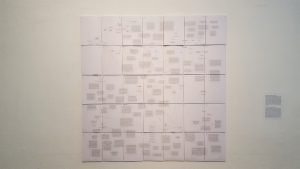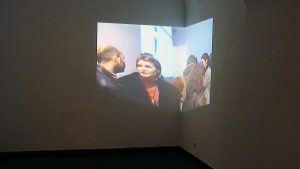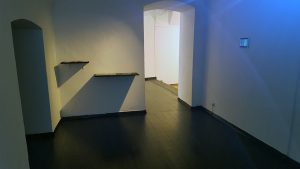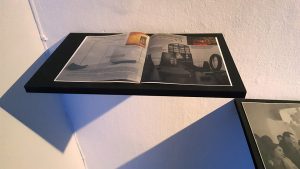re- Exhibition on the occasion of the twentieth anniversary of the World of Art
9 – 26 May 2017, Škuc Gallery, Ljubljana
Blaž Miklavčič, Orientation Scheme, 2016–2017
The investigative artwork Orientation Scheme is taking shape in the form of conversations with the protagonists of the Ljubljana art scene, and deals with researching particular relationships that define the institutional framework of local contemporary art production. The conversations, whose main focus was on the problems of the Slovenian art scene, such as cultural policy, issues of public financing, lack of a private market, crisis of criticism and smallness, as well as the character of the art scene, are presented in the form of a diagram which extends over thirty-five sheets. The network consists of authorized statements, the place and time of the meetings, with connections being established in view of what the artist learnt during the conversation. The scheme does therefore not seek the impossible task of concurrently representing the state of the Slovenian art scene, but creates a plane that maps one’s own bewildering experience of getting to know the local artistic context from a marginal position of an art student, which is also characterized by an uncertain sense of belonging to the local art system. Trying to orient and familiarize oneself with the system – deciphering the protagonists, venues, power relations, affairs and concerns that are identified as important during the process, proves to be a process that structurally transforms its own place within the art network, which ultimately also frames the construction of the territory of the creative activities of young artists.
Maja Burja
More Orientation Scheme Descriptions on Slovene version of WoA page.
Rene Rusjan, Present Situation, 1997/2017
Present Situation is a complete re-install of artist’s piece from the first World of Art exhibition in 1997 (This Art Is Recycled) into the same gallery space. The multi-part video installation consists of the of the video documentation artist’s sculpture exhibition in 1991, the recorded opening and the catalogue of Yesterday, for example* exhibition at Mala galerija, and a book containing the photographs of the sculptures by the artist.** The repetition also presents the difference, since the artist has juxtaposed the video projection with a commentary – the same video is shot on a tablet using face recognition tools, which acts as a response to its placement into a new context, a new time and a new perception of one’s own work from twenty years ago.
* With the exhibition Yesterday, for example on view in 1997 at Mala galerija, the artist returns to the gallery space which she inhabited with her previous sculpture exhibition some years ago (1991). She was interested in the relationship established between the artworks and the space which they inhabited temporarily. This led her to choose those past exhibitions at Mala galerija that had most marked its space. She appropriated the recordings of installations of Michelangelo Pistoletto and Uri Tzaig, inserting new content into the formal repetition. The projection of Tzaig’s work was succeeded by footage of the openings of various exhibitions at Mala galerija, whereas the photographs of the same exhibitions replaced Pistoletto’s 44 ceramic tiles.
** The book of photographs, which can be read as a reproduction of the artist’s principle of recycling, features the photographs of her last sculpture exhibition Cycle Recycle (Škuc Gallery, 1992). The sculptures were present only in the books of photographs exhibited in three rooms, whereas the pieces that had once formed sculptural installations were generally left as ‘dormant material’, placed as if on stage, behind a string, which restricted walking through and around, so that they could be seen only from afar. The mentioned photographs of the show are joined as an intervention by a photo of the installation view of the exhibition This Art Is Recycled. The form of the exhibited folders from the exhibition Cycle Recycle is also reiterated by the juxtaposition of the catalogue Yesterday, for example which was edited by Igor Zabel from a collection of old material by imitating the artist’s recycling principle.
Video: Documentary material from the Moderna galerija Information Centre, 1991−1997, camera Siniša Lopojda.
Photos from SCCA-Ljubljana Archive.



